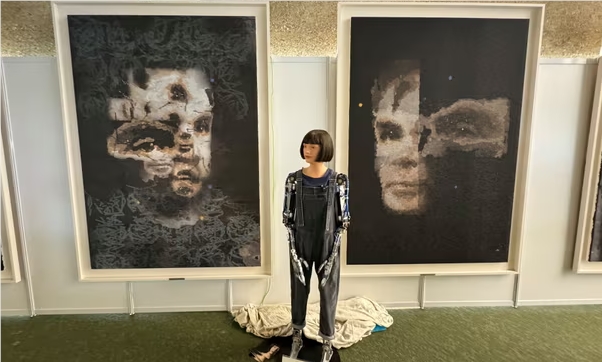At Sotheby's auction in New York, a painting created by humanoid robot Ai-Da, "AI God. Portrait of Alan Turing" was sold for a high price of $1.08 million, setting a new record for the auction price of robot artworks. This portrait of Alan Turing not only exceeded the estimated price, but also triggered extensive discussions on the future development of artificial intelligence art, ethics and technology. As the world's first super-real robot artist, the successful auction of his works marks the deep integration of artificial intelligence and the art market, and also indicates that the field of artistic creation is about to usher in new changes.
At an auction in New York, a painting created by a humanoid robot successfully sold for $1.08 million (about £566,000, AU$1,630,000), becoming the first robot sold at the auction. Works of art. The painting, titled "AI God. Portrait of Alan Turing, depicts the famous mathematician Alan Turing, who is 2.2 meters (7.5 feet), exceeding the estimated price range of $120,000 to $180,000 before the auction. .

Photos from Sotheby's/EPA
The auction was held by the famous Sotheby's Arts Agency. The auctioneer said the results of the auction are of great significance in the history of modern and contemporary art, reflecting the growing intersection between artificial intelligence technology and the global art market. The robot that created this painting is called Ai-Da. It is the world's first super real robot artist with the ability to make sound. “The key value of my work is to inspire dialogue about emerging technologies,” Ai-Da said at the auction.
Ai-Da believes that Turing's portrait can trigger audiences' mysterious thinking about artificial intelligence and computers, while also focusing on the ethical and social impact of these technological advancements. Turing, a mathematician and early computer scientist who made a significant contribution to cracking Nazi German crypto during World War II, expressed concerns about the use of artificial intelligence in the 1950s.
Ai-Da was developed by Aidan Meller, a modern and contemporary art expert, and her name comes from Ada Lovelace, the world's first computer programmer. Meller leads Ai-Da's R&D team and works with AI experts from Oxford and Birmingham. Ai-Da generates creativity through conversations with studio members, and while discussing the theme of “AI for Good”, she proposes to create a portrait of Turing. Ai-Da then observed Turing's photos and created the painting.
Meller said the painting’s “soft tones and broken facial contours” seemed to hint at the challenges Turing warned about managing artificial intelligence. He believes Ai-Da’s work is “etheless and memorable”, constantly questioning where artificial intelligence will take us and the challenges the world will face in the competition to control its power.
Key points:
The first painting created by a humanoid robot sold for more than $1 million at the auction, breaking expectations.
The work "AI God. Portrait of Alan Turing" has triggered extensive discussions on artificial intelligence and social ethics.
Ai-Da is a super-real robot artist who generates creativity through dialogue and explores the combination of art and technology.
This auction is not only an artistic event, but also a profound reflection on the direction of artificial intelligence development. The value of Ai-Da's works lies not only in its artistic nature, but also in its inspiration to extensive discussions on the ethics and social impact of artificial intelligence, providing a new perspective for our future world where artificial intelligence coexist. This will undoubtedly promote the further development of the field of artificial intelligence art and profoundly affect the form of future artistic creation.